World Monuments Fund (WMF) is a private, international, non-profit organization dedicated to the preservation of historic architecture and cultural heritage sites around the world through fieldwork, advocacy, grantmaking, education, and training.
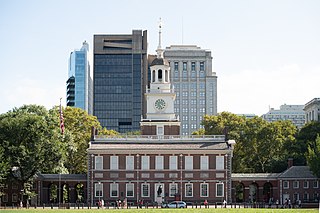
A National Historic Landmark (NHL) is a building, district, object, site, or structure that is officially recognized by the United States government for its outstanding historical significance. Only some 2,500 (~3%) of over 90,000 places listed on the country's National Register of Historic Places are recognized as National Historic Landmarks.

The Graduate School of Architecture, Planning and Preservation at Columbia University in New York City, also known simply as GSAPP, is regarded as one of the most important and prestigious architecture schools in the world. It is also home to the well-regarded Masters of Science program in Advanced Architectural Design, Historic Preservation, Real Estate Development, Urban Design, and Urban Planning.

Historic preservation (US), heritage preservation or heritage conservation (UK), is an endeavor that seeks to preserve, conserve and protect buildings, objects, landscapes or other artifacts of historical significance. It is a philosophical concept that became popular in the twentieth century, which maintains that cities as products of centuries’ development should be obligated to protect their patrimonial legacy. The term refers specifically to the preservation of the built environment, and not to preservation of, for example, primeval forests or wilderness.

The J. Paul Getty Trust is the world's wealthiest art institution with an estimated endowment in 2017 of $US 10.1 billion.
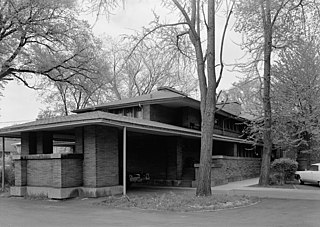
The Darwin D. Martin House Complex, also known as the Darwin Martin House National Historic Landmark, was designed by Frank Lloyd Wright and built between 1903 and 1905. Located at 125 Jewett Parkway in Buffalo, New York, it is considered to be one of the most important projects from Wright's Prairie School era, and ranks along with The Guggenheim in New York City and Fallingwater in Pennsylvania among his greatest works.

Jack E. Boucher was an American photographer for the National Park Service for more than 40 years beginning in 1958. He served as the Chief Photographer for the Historic American Buildings Survey (HABS). In 1966 he left the Park Service for two years to supervise New Jersey's State Historic Preservation program, including the State's roadside marker program, 18 historic museum houses, several lighthouses, and two historic villages. Offered his old job back by the Park Service/HABS in 1970, he left New Jersey to return to NPS/HABS and the highly specialized job of large format photographic architectural documentation. His work took him to 49 States, the Virgin Islands and Puerto Rico. April 2008 was the fiftieth anniversary of his employment with the National Park Service's "HABS" program. He traveled with 900 pounds of photographic equipment.

Conservation and restoration of immovable cultural property describes the process through which the material, historical, and design integrity of any immovable cultural property are prolonged through carefully planned interventions. The individual engaged in this pursuit is known as an architectural conservator-restorer. Decisions of when and how to engage in an intervention are critical to the ultimate conservation-restoration of cultural heritage. Ultimately, the decision is value based: a combination of artistic, contextual, and informational values is normally considered. In some cases, a decision to not intervene may be the most appropriate choice.
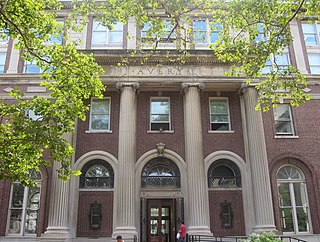
The Avery Architectural and Fine Arts Library is a library located in Avery Hall on the Morningside Heights campus of Columbia University in the New York City. It is the largest architecture library in the world. Serving Columbia's Graduate School of Architecture, Planning and Preservation and the Department of Art History and Archaeology, Avery Library collects books and periodicals in architecture, historic preservation, art history, painting, sculpting, graphic arts, decorative arts, city planning, real estate, and archaeology, as well as archival materials primarily documenting 19th- and 20th-century American architects and architecture. The architectural, fine arts, and archival collections are non-circulating. The Ware Collection, mainly books on urban planning and real estate development, does circulate.
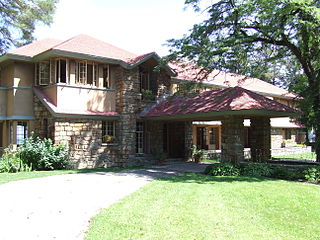
The Graycliff estate was designed by Frank Lloyd Wright, and built between 1926 and 1931. It is located 13 miles (21 km) southwest of downtown Buffalo, New York, at 6472 Old Lake Shore Road in the hamlet of Highland-on-the-Lake, with a mailing address of Derby. Sometimes called "The Jewel on the Lake", Graycliff is sited on a bluff overlooking Lake Erie with sweeping views of downtown Buffalo and the Ontario shore.
Charles Emil Peterson (1906–2004) is widely considered to be a seminal figure in professionalizing the practice of historic preservation in the United States. He is referred to as the "founding father" of the professional advocation of historic preservation, the "godfather of preservation," and an "extraordinary preservationist" who made important contributions to the knowledge of early American building practices, helped create the profession of the preservation architect, and passionately advocated for the retention and restoration of the American built heritage. According to Jacques Dalibard, a professor at McGill University School of Architecture, "with James Marston Fitch, I cannot think of two people who had more influence on historic preservation in North America."

The Whitney Museum of American Art original building is a collection of three 1838 rowhouses located at 8–12 West 8th Street between Fifth Avenue and MacDougal Street in the Greenwich Village neighborhood of Manhattan, New York City. In 1907, Gertrude Vanderbilt Whitney established the Whitney Studio Gallery at 8 West 8th Street adjacent to her own MacDougal Alley studio. This, and the later Whitney Studio Club at 147 West 4th Street, were intended to provide young artists with places to meet and exhibit their works.

Andrew Scott Dolkart is a professor of Historic Preservation at the Columbia University Graduate School of Architecture, Planning and Preservation (GSAPP) and the former Director of the school's Historic Preservation Program. Professor Dolkart is an authority on the preservation of historically significant architecture and an expert in the architecture and development of New York City. He was described as someone who is "without peer among New York's architectural researchers" by architectural critic Francis Morrone and he has written extensively on this topic. Before joining the faculty at Columbia he held a position at the New York City Landmarks Preservation Commission and worked as a consultant. Dolkart holds a Bachelor of Arts degree from Colgate University (1973) and a Master of Science degree in Historic Preservation from Columbia University (1977); he is a popular lecturer and walking tour guide.
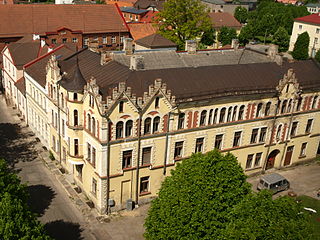
A historic district or heritage district is a section of a city which contains older buildings considered valuable for historical or architectural reasons. In some countries or jurisdictions, historic districts receive legal protection from certain types of development considered to be inappropriate.

Frank Sagendorph Welsh is president of the U.S.-based Frank S. Welsh Co., a company that analyzes old paints and wallpapers; their pigments and fibers.
In historic preservation, sustainable preservation is the idea that preservation has tangible ecological benefits, on the basis that the most sustainable building is one that is already built. Historic buildings can have advantages over new construction with their often central location, historic building materials, and unique characteristics of craftsmanship. Arguing for these connections is at least partially an outgrowth of the green building movement with its emphasis on new construction. Sustainable preservation borrows many of the same principles of sustainable architecture, though is unique by focusing on older buildings versus new construction. The term "sustainable preservation" is also utilized to refer to the preservation of global heritage, archaeological and historic sites through the creation of economically sustainable businesses which support such preservation, such as the Sustainable Preservation Initiative and the Global Heritage Fund.

The Sherry-Netherland is a 38-story apartment hotel located at 781 Fifth Avenue on the corner of East 59th Street in the Upper East Side neighborhood of Manhattan, New York City. It was designed and built by Schultze & Weaver with Buchman & Kahn. The building is 560.01 feet (170.69 m) high, and was noted as the tallest apartment-hotel in New York City when it opened.
Morgan W. Phillips (1943–1996) was an American founder of the field of architectural conservation. He is credited with coining the term "architectural conservation" in the early 1970s and was among the first to call himself an architectural conservator. Phillips worked for most of his career at the Society for the Preservation of New England Antiquities (SPNEA) in Boston, now Historic New England, and the organization's Conservation Center was largely built around his research and that of his apprentices.

Jorge Otero-Pailos is an artist, preservation architect, theorist and educator, commonly associated with experimental preservation and the journal Future Anterior. He is best known for his “The Ethics of Dust” ongoing series of artworks derived from the cleaning of monuments, which was exhibited at the 53rd Venice Biennale. Westminster Hall, the Victoria & Albert Museum, and SFMoMA, amongst others. He is Director and Professor of Historic Preservation at Columbia University Graduate School of Architecture, Planning and Preservation.
The Association for Preservation Technology International (APT) is a not-for-profit, multidisciplinary, membership organization dedicated to promoting the best technology for conserving and preserving historic structures and their settings. Founded in 1968 by preservationists from Canada and the United States, it now has 1,500 members from 30 countries, with headquarters in Springfield, Illinois. APT’s activities include conferences, training and education programs, and publications on the technical aspects of preservation.













